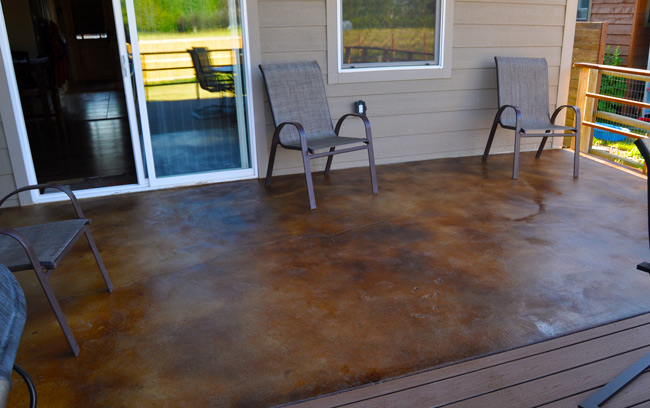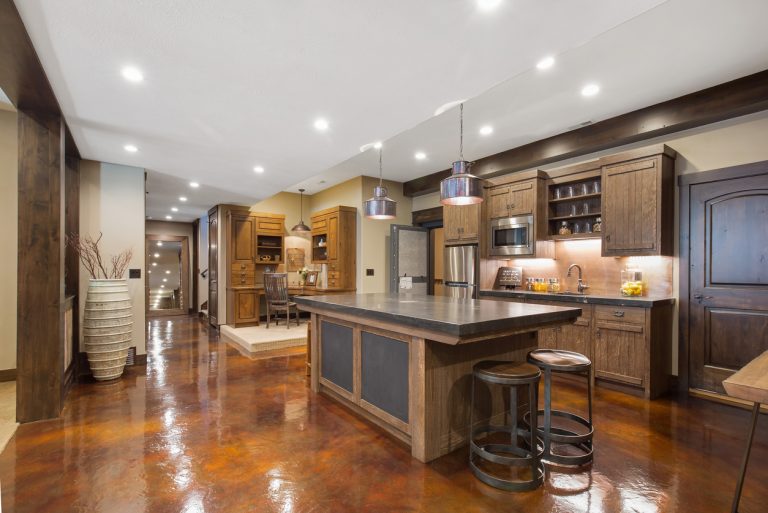Beginner’s guide to stained concrete designs
Everything About Stained Concrete: A Comprehensive Guide to Its Benefits and Applications
Stained concrete has become a preferred selection for both property and industrial rooms. Its capability to incorporate visual charm with practicality makes it a fascinating alternative. Numerous staining techniques offer an array of colors and surfaces, enabling modification. The advantages expand past appearance. Understanding its applications and upkeep needs is vital for any individual considering this flexible product. The subtleties of stained concrete invite additionally expedition.
What Is Stained Concrete?

Staining can be applied to numerous surfaces, consisting of floors, driveways, and patios, making it a functional option for both interior and exterior areas. The treatment can achieve an array of looks, from earthy tones to bold, modern styles. Unlike paint, stained concrete maintains its appearance gradually, as it comes to be an indispensable part of the concrete itself. On the whole, stained concrete functions as a reliable technique for changing ordinary concrete right into visually striking surfaces.
Benefits of Stained Concrete
Stained concrete deals significant advantages, particularly in aesthetic allure and durability - local stained concrete. Its vivid shades and special patterns boost the visual charm of any room, making it a popular selection for both domestic and industrial applications. In addition, the long life of stained concrete warranties that it continues to be a useful financial investment in time, standing up to damage
Visual Allure
One of one of the most compelling benefits of using stained concrete is its impressive visual charm. Stained concrete offers an unique and versatile appearance that can match different style styles, from contemporary to rustic. The infusion of vibrant shades and intricate patterns allows property owners and designers to produce tailored surfaces that can enhance the total atmosphere of an area. Unlike standard floor covering alternatives, stained concrete can resemble the appearance of all-natural rock or refined marble, supplying an upscale look without the linked prices. Furthermore, the glossy coating choices can reflect light, further brightening insides. This versatility makes stained concrete a preferred choice for both household and commercial applications, where visual effect is vital.
Toughness and Longevity
The impressive aesthetic top qualities of stained concrete are enhanced by its impressive durability and longevity - stained concrete. Stained concrete surface areas are resistant to damage, making them ideal for high-traffic areas both indoors and outdoors. Their durable nature means they can withstand severe climate condition, consisting of severe temperature levels, rain, and UV direct exposure, without considerable degradation. In enhancement, stained concrete needs marginal upkeep contrasted to various other floor covering alternatives, as it does not need constant securing or refinishing. This long life not only decreases substitute prices but additionally adds to a sustainable building approach. On the whole, stained concrete provides a long-lasting solution that incorporates visual allure with functional benefits, guaranteeing its value with time
Various Types of Staining Techniques
Various discoloration strategies can significantly impact the visual high qualities of concrete surfaces. The three main approaches consist of acid discoloration, which reacts chemically with the concrete, water-based staining, which provides a more comprehensive array of colors, and overlay discoloration choices that give a fresh surface. Each technique has one-of-a-kind qualities and applications that satisfy different style choices and task demands.
Acid Staining Approach
How can homeowners transform plain concrete surface areas into aesthetically striking features? One reliable approach is acid discoloration, a preferred strategy that enhances the natural appeal of concrete. This procedure includes using a solution of water, hydrochloric acid, and metal salts to the concrete surface. As the acid reacts with the lime existing in the concrete, it creates rich, variegated shades that resemble marble or stone. Acid discoloration is known for its sturdiness and resistance to fading, making it a durable choice for both interior and exterior applications. It is necessary to keep in mind that the outcomes can vary based on the original concrete shade and structure. Appropriate application and securing are essential for accomplishing the preferred aesthetic and long life
Water-Based Discoloration Strategy
A prominent alternative to acid discoloration, the water-based staining technique uses homeowners a functional way to improve concrete surface areas. This technique utilizes water-soluble dyes and pigments, permitting a large range site of shades and finishes. Unlike acid discolorations, water-based discolorations can be put on unsealed concrete and supply a less complicated cleaning process. The outcomes can achieve a much more uniform look and can be layered to produce distinct results. Furthermore, water-based spots are usually less poisonous and give off less unstable natural substances (VOCs), making them a lot more eco pleasant. Homeowners might appreciate the capability to customize their concrete surfaces with numerous shades, permitting for innovative expression while preserving resilience and longevity in their flooring selections.
Overlay Discoloration Options
Numerous overlay staining alternatives exist for property owners wanting to revitalize their concrete surfaces. One prominent choice is acid staining, which reacts chemically with the concrete to create rich, variegated colors. One more alternative is water-based discoloration, offering a wider color palette and less complicated application. In addition, concrete overlays can be integrated with stencils for complex styles, enhancing aesthetics. For a more distinctive surface, homeowners may think about utilizing stamped overlays that mimic all-natural products like rock or floor tile. Each technique provides one-of-a-kind advantages, from resilience to customization, allowing for a customized touch. Ultimately, the selection of overlay staining depends on the wanted look and the problem of the existing concrete, making certain a freshened and appealing surface.
Applications of Stained Concrete
Stained concrete offers a versatile solution for various applications, enhancing both visual charm and performance. This product is frequently used in residential, industrial, and commercial settings, making it a prominent option amongst architects and designers. In homes, stained concrete can work as stylish flooring or exterior patio areas, supplying an advanced look while staying long lasting.
In industrial areas, such as retailers and restaurants, stained concrete adds to a modern-day setting and can withstand heavy foot traffic. Additionally, stained concrete is significantly used in public rooms like parks and sidewalks, where its capacity to imitate all-natural stone or various other products includes aesthetic passion.
In addition, stained concrete is suitable for swimming pool decks and driveways, offering a slip-resistant surface that is very easy to keep. Generally, the flexibility of stained concrete makes it suitable for numerous settings, accommodating diverse tastes and demands.
Maintenance and Look After Stained Concrete
Appropriate upkeep ensures the longevity and charm of stained concrete surfaces. Regular cleansing is necessary; making use of a moderate detergent and water with a soft-bristle brush helps eliminate dust and gunk without damaging the surface. It is suggested to prevent harsh chemicals that can remove away the stain or sealer.
Sealing stained concrete is important for protection against wetness, stains, browse around here and put on. A premium sealer must be reapplied every one to three years, relying on the website traffic and direct exposure the surface area sustains. Additionally, addressing spills immediately will prevent staining and staining.

Cost Considerations for Stained Concrete Projects
When planning a discolored concrete task, budget considerations play a necessary role in establishing the overall expense. The expenses related to stained concrete can vary considerably based upon numerous factors. Initially, the size of the location to be stained directly affects material and labor costs. Bigger areas will naturally need more resources. Second, the kind of discolor picked-- acid-based or water-based-- can impact rates, with acid stains typically being extra costly. In addition, the intricacy of the design, including patterns or numerous shades, can boost labor expenses. Preparation job, such as cleaning and grinding the concrete surface area, includes in the first costs also. The option in between DIY installation and working with a specialist service provider will better impact the spending plan. Comprehending these factors enables house owners to make educated monetary choices about their stained concrete tasks, guaranteeing they achieve the wanted aesthetic within their economic ways.
Tips for Choosing the Right Stained Concrete for Your Area
Choosing the appropriate stained concrete for a particular area includes mindful reflection of various variables beyond simply spending plan. First, one ought to examine the intended use the location. High-traffic zones may require even more sturdy surfaces, while ornamental applications can prioritize visual appeals.
The color combination is another essential element; the chosen shades ought to balance with existing style and illumination. It's likewise crucial to consider the surface texture, as smooth surfaces can boost sophistication, while textured choices may ensure safety and security in damp locations.
Regional environment and ecological conditions play a considerable duty in the durability and upkeep of stained concrete, influencing the selection of sealers and coatings.
Lastly, talking to specialists can provide beneficial understandings tailored to specific requirements, ensuring the choice of the perfect stained concrete that lines up with both capability and design.

Regularly Asked Inquiries
Can Stained Concrete Be Applied Over Existing Floor Covering?
Stained concrete can without a doubt be applied over existing flooring, offered the surface area is secure and appropriately prepared. This approach permits an aesthetic upgrade without the demand for complete removal of the original flooring materials.
For How Long Does Stained Concrete Last?
Stained concrete can last for decades when effectively kept. Elements such as website traffic, environmental conditions, and application strategies significantly influence its longevity, with several installations staying vivid and intact for 10 to 30 years.
Is Stained Concrete Slippery When Wet?
Stained concrete can be slippery when damp, as the coating might produce a smooth surface area. However, utilizing non-slip ingredients or distinctive coatings can minimize this concern, enhancing security without endangering the visual allure of the concrete.
Can I Discolor Concrete Myself, or Should I Hire a Specialist?
The choice to stain concrete personally or work with a professional depend upon skill level and project complexity. our website While DIY discoloration can save money, experts assure excellent results, specifically for elaborate styles or big surfaces.
What Color styles Are Available for Stained Concrete?
The variety of colors offered for stained concrete includes earthy tones like browns and tans, vivid tones such as reds and blues, and softer hues like pastels. This palette enables innovative, individualized layout options.